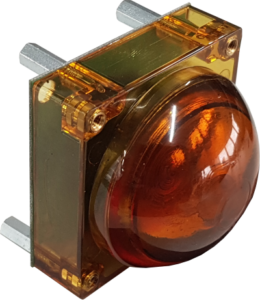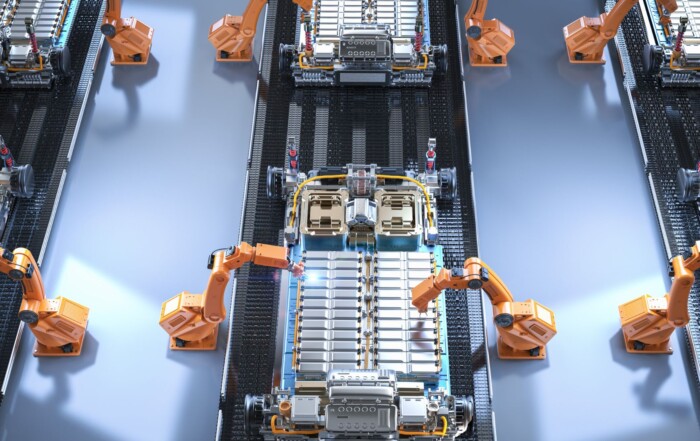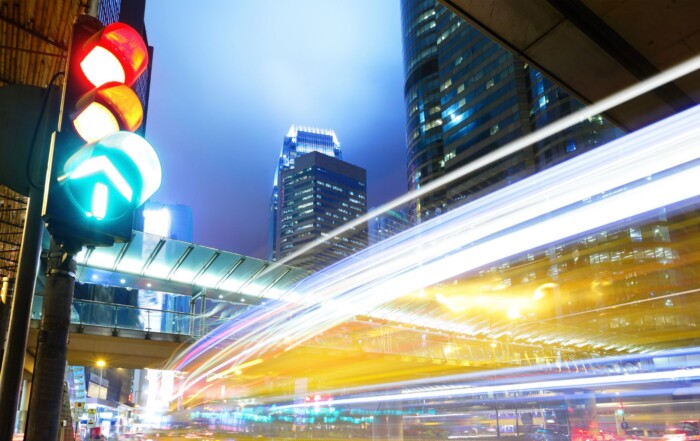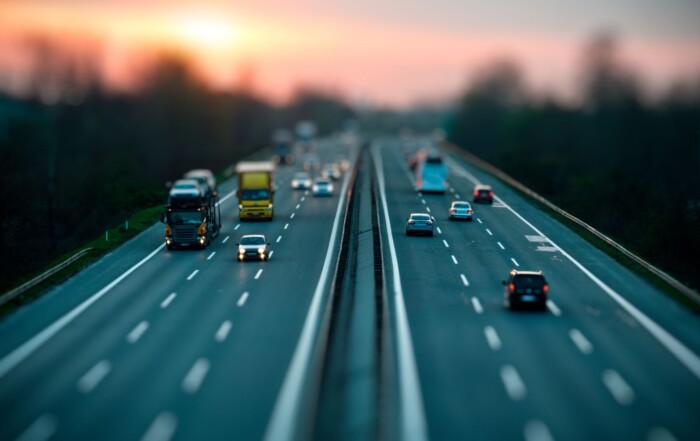Keep a distance for more safety
Prevent collisions with radar distance measurement
If vehicles collide with objects or persons, this will result in body damage and scratches at the very least and may even cause serious injuries and a vehicle breakdown. In order to avoid such accidents, there are already clever solutions available for our everyday lives. For example, this might include in-car warning systems that prevent collisions when reversing or that maintain a minimum distance while driving. We rely on sensors in situations where we have a hard time keeping track of people.
This has long been normal for many people in street traffic, but sensor-based control is only just starting to take off in industry. Yet there are a number of good reasons to use collision-protection products in this field in particular. Large, difficult-to-manoeuvre vehicles are in use there – often under difficult environmental conditions. When it comes to automated production processes, transport, and positioning, sensor technology is even absolutely necessary, because only with sensors is it possible to interact with the environment.
In smart factories, vehicles and mobile machines move autonomously or freely in space. Robots can only be established if they are equipped with safety functions and are aware of their environment. As people and technology work together more and more, there is an increasing need for pre-crash systems.
The benefits of collision protection sensors are undeniable. But why isn’t every heavy-duty transporter, crane, special machine, construction vehicle, or forklift truck in a factory building equipped with such a warning system?
Big challenges for the equipment
To start with, the price is often the deal-breaker. Retrofitting each individual machine is expensive and labour-intensive. Companies have thus been turning to very low-cost, simple solutions – such as conventional ‘beepers’ or protective grilles for stationary production machines. They often have disadvantages (required space) or are not as efficient as desired.
Another obstacle is that the special requirements for industrial use entail significant development work. After all, sensors must always function reliably and perform extremely precise measurements. Many challenges also arise from the environment of the area of application. One example is an off-road machine such as a large excavator for extracting construction materials. In rainy weather and mud, the sensor is supposed to protect against collisions despite the dirt.
At the same time, modern trends like automation and digitalisation in industry are driving up demands placed on the equipment. Sensors do more than issue warnings – they trigger a reaction, such as throttling the travel speed or stopping the machine. In order to increase the acceptance of autonomously / partially autonomously operating or moving machines, the risk of accidents must be reduced to a minimum. And products for collision protection are becoming indispensable.
Industry requirements
It takes the most advanced technology available in order to meet the industry’s needs. Continuous distance determination is a prerequisite in order to prevent collisions. The collection of further measurement data, such as speed or direction of movement, also enables the environment to be recorded in better detail. Detection must be as accurate as possible – with no impairments as a result of malfunctions, in order to avoid injuries and property damage in any situation. This means environmental influences must not impair functionality, and the sensors must be suitable for indoor and outdoor use.
They are often installed behind bumpers, housings, or mobile components of a machine. The altered perspective resulting from varying installation positions and the cover should not pose a problem for the sensors. The sensors must detect static as well as slowly moving objects in order to recognise approaching or crossing vehicles and people. Since they serve as triggers for a technical function, they have to be able to be integrated. Products that boast such extensive functions and precise performance are still relatively new to the market. Not just any measuring technology is suitable for this purpose, and not all technologies meet these challenges.
Radar distance measurement
Radar technology is a well-suited measuring method and features important characteristics for reliable performance in harsh industrial environments. When measuring distance with radar, an antenna continuously emits electromagnetic microwaves at the speed of light as pulses.
These pulses then spread into the antenna’s directivity in a targeted and focused manner. If they hit the surface of an object, they are dispersed and some of the energy is reflected back.
As soon as an object or a person is within range of the radar, the sensor receives a sort of echo. The signal is modified due to the reflection, object properties, and distance travelled. The distance of the obstacle to the sensor can be determined based on the response signal and required duration. The detection is subsequently analysed. This is an important step in order for the user to not only see a cloud of points but also receive data they can assess. Possibilities unique to this technology must be taken into account in this process, such as filters and configuration options which refine and optimise data collection. The radar then passes on the resulting information to the user.
Through radar integration, machines can react to changes in distance in the environment. The continuous, non-contact measurement of distances enables the required safety distance to be maintained. And the information outputted from the radar forms the basis for programming automatic sequences (trigger function). When a certain proximity of an object to the sensor has been reached, this triggers a warning function or reaction. For example, the machine might slow down, an alarm might sound, a lock might engage, or the machine might shut down or reverse. This enables people in the environment to be warned and necessary safety functions to be initiated in order to prevent collisions.
How radar sensors meet industry requirements
Radar development has made considerable progress in recent years. Finally, complex systems are available to the market that can withstand the demands of industry. The experts can meet the technical challenges by performing the right development work. Collision protection radar units continuously emit pulses to prevent the protective function from being interrupted. The radar quickly processes and analyses the detected data in order to be able to respond reliably to objects or persons within the coverage area. For this purpose, developers utilise advanced signal-processing units that trigger reactions immediately. Filters for interference factors or other settings as well as a focused antenna design also serve to optimise data output. With some applications, it makes sense to establish a standby mode that also saves power. For example, the sensor might only be activated while a vehicle is reversing. With an accelerated measuring cycle, the developers ensure that the radar nonetheless remains ready for use immediately.
60 GHz radar for collision protection
However, performance plays a major role in collision protection. The frequency bands relevant to industrial distance measurement have not been available to radar developers for long. Only since they became available has it been possible to utilise higher resolutions and achieve highly precise detection.
While 24 GHz solutions for extremely small measurements are too imprecise for positioning tasks, 60 GHz offers better results, especially for objects with a small radar cross-section. This is due to the larger bandwidth available at higher frequencies. The radar measures with millimetre accuracy from a long distance and clearly distinguishes the different distances of the individual detection points.
Since 60 GHz radars have been in use for industrial applications, the demand for radar solutions in collision protection has been on the rise. Thanks to its further development, the technology constitutes a serious alternative to laser or video equipment. Compared to other measuring methods, radar boasts a crucial advantage, as it is extremely robust and thus can be used in a wide variety of ways. Bad weather, darkness, heat, cold, dirt, noise, dust, or vibrations don’t impair the device’s functionality. Even skewed or tilted positions do not impair detection. This technology particularly proves its benefits where other solutions fail. The sensors are ideal for harsh industrial environments and working under extreme conditions.
More options for robotics & collision protection
For more complex applications, such as controlling self-driving means of transport in factory buildings, the next developments are already in the starting blocks. And radar technology has great potential here as well. That’s why InnoSenT is working on developing high-tech sensor solutions for collision protection and navigation in the fields of robotics and AGVs. The radar products enable the environment to be monitored in three dimensions and provide extensive object information, such as speed or direction of movement.
Additional features such as tracking and object classification further boost the systems’ efficiency. In the future, the advanced radar solutions will do much more than simply help avoid collisions. They will minimise the risk of injury and damage and contribute to productivity by anonymously collecting data and reducing accidents.
And they are already a vital element for self-driving cars. Tomorrow, they will provide this safety and reliability to industry and pave the way for collaborative work as well as autonomous machines and transporters.
Share This Content
Product highlight for collision protection

The iSYS-6030 60 GHz radar system performs accurate, non-contact distance measurement down to the millimetre. As an update of the iSYS-6003 radar system from InnoSenT, it boasts several enhancements: The product is even faster and more accurate. It detects slow-moving and static objects up to 40 metres away. The radar has a narrow and focused 6° radar beam and distinguishes targets at a distance of 12 cm. The compact system is equipped with four programmable digital outputs used to trigger a reaction.


